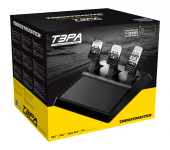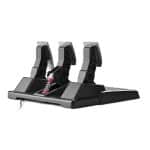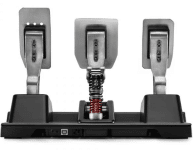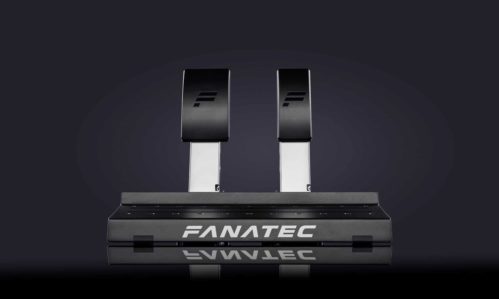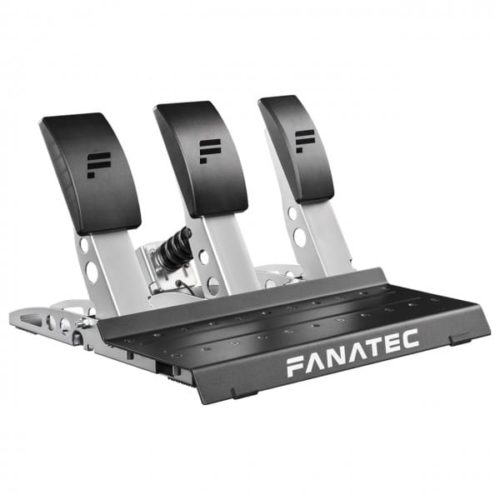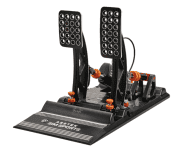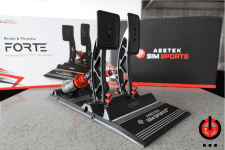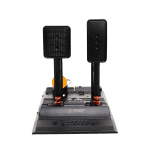The great guide to simracing pedalsets!
It’s a fact known to all simracers: when it comes to simracing equipment, don’t skimp on your choice of pedals. It’s your pedals, and especially your brake pedal, that will enable you to perform better on the track and achieve faster, more consistent times. In this great guide to simracing pedalsets, we’ll take a look at all the different types of pedalsets out there, and find THE pedalset for you. In terms of performance , price and feel. Ready to go? Let’s get started!
How to choose the right simracing pedalset?
Performance, through constant precision
Immersion, through sensations
Position, for comfort Price
Price, for the banker
When choosing a pedalset, there are 4 main factors to consider. First, pure performance. You need a pedalset that allows you to repeat each braking action with precision, to optimize your consistency, the most important point in racing.
Like all gamers, you’re undoubtedly looking for sensations that are as immersive as possible. After all, the whole point of car simulation is to feel like you’re driving a real racing car.
Bear in mind, too, that your driving position will make a big difference to your comfort, feel and performance. Your pedalset should be able to adapt perfectly to you, not the other way around. So avoid pedalsets that offer little or no adjustment.
Finally, of course, price will determine which category of simracing pedalset you can afford. Don’t dream of a top-of-the-range hydraulic pedalset if your budget is only a few hundred euros.
A brief summary of the world of simracing pedalsets
| Pédalier | Technologie | Capteurs | Prix moyen |
|---|---|---|---|
| Fanatec CSL Pedals | Ressorts | Magnétiques | 80€ |
| Thrustmaster T3PM | Ressorts | Magnétiques | 130€ |
| Thrustmaster T3PA | Ressorts et caoutchouc | Potentiomètres | 140€ |
| Thrustmaster T-LCM | Ressorts et mousses haute densité | Magnétique et Load Cell | 200€ |
| Fanatec CSL Pedals LC | Ressorts et mousse haute densité | Magnétiques et Load Cell | 200€ |
| Fanatec Clubsport V3 et V3 Inverted | Ressorts et mousse haute densité | Magnétiques et Load Cell | 360€ à 600€ |
| Heusinkveld Sprint | Ressorts et mousse haute densité | Magnétiques et Load Cell | 680€ |
| Simtag Hydraulic 2 pedals racer edition | Ressorts et Hydraulique | Magnétiques et Load Cell | 1610€ |
Technologies used in simracing pedalsets
Depending on price range and brand, different technologies are offered in pedalboards to make them as precise and immersive as possible. The differences in technology have a particular impact on your brake pedal. Your brake can be your best ally or your Achilles heel in simracing. It’s thanks to the quality of your braking that you’ll be able to set better times and gain in consistency.
So let’s take a look at what the manufacturers have to offer to make you a racing beast!
Spring-loaded pedalsets
Let’s start with spring pedals. This system is found on all entry-level and mid-range pedalsets. The spring behind each pedal enables you to obtain more or less hardness, but the pressure to be exerted on the pedal is linear. In other words, there’s no difference in pressure whatever the pedal stroke. So, in terms of feel, it’s very basic and not very immersive.
The other disadvantage of springs is that their linear pressure doesn’t give you any reference points to help your leg replicate each time the perfect dosages to make turns as regular as possible.
To improve your simracing pedalset, most brands offer spring kits of varying degrees of hardness to enhance your feel.
High-density foam and spring pedalsets
The second technology is springs combined with high-density foams. Here, we finally have access to non-linear pressure. Your foot first presses against the spring, then compresses the harder foam. This technology is widely used in mid-range and high-end pedalsets.
In concrete terms, when you depress the spring, your pedalset’s electronics will advance your braking force in a linear but reduced fashion. For example, you press the pedal 60% of the way down, but the braking applied is only 30%.
Then you hit the foam, feel the increased hardness and the remaining 40% of pedal travel will apply 70% of the braking. Of course, these figures are taken at random to help you understand the concept. In reality, any setting is possible!
Having two different pressures to apply to the pedal allows you to find your bearings better and be more precise.
To enhance your playing experience, brands offer spring and foam kits of different hardnesses. So you can easily adapt your pedalset to suit your tastes!
Hydraulic pedalsets
Simracing hydraulic pedalsets are considered the holy grail of pedalsets. It’s a technology reserved for top-of-the-range models priced from €1,000 to over €3,000. But is it really technically worth it?
In fact, in a hydraulic pedalset, instead of springs and foams, you find a master cylinder that will be compressed by the pedal. This cylinder is filled with fluid which passes through a hose from the master cylinder to a slave cylinder. This slave cylinder in turn transfers the pressure to a spring and a high-density foam.
In the end, we end up with the same technology as spring-and-foam pedalsets! We’ve just moved the spring and foam away from the pedal and inserted intermediate cylinders.
So OK, the feel is slightly different from other models, but your braking precision won’t be improved in any way. In my opinion (and this is just my opinion), unless you’ve fallen deeply in love with the concept, it’s not worth the money.
Air-sprung pedalsets
Air springs simply replace the metal spring with a piston into which your foot compresses air. You’ll find them at Fanatec, for example, which offers pneumatic kits to improve the feel of clutch and brake pedals.
But in concrete terms, I haven’t perceived any performance improvement that would justify paying the price.
Simracing pedal sensors
Now that we’ve taken stock of the technologies available to “actuate” your pedals, let’s move on to the sensors that will transmit the information from your pedalboard to your console or PC.
Potentiometer pedals
Potentiometers have been part of your daily life for decades. Changing the volume of your car radio, modifying the bass on your mixer, adjusting the brightness of a lamp..
In a pedalboard, the potentiometer is used to set the angle of the pedal to which it is attached. It’s a very efficient system, but only found on entry-level pedalboards.
But why? Well, because it’s a very inexpensive solution, but it has its limits. First of all, it involves moving mechanical parts. And like all moving mechanical parts, they wear out.
And over time, dust can interfere with their precision, or even create “parasites” in the signal.

This is a common problem with guitars, for example. A poor-quality potentiometer will end up sizzling when you turn it. But that doesn’t mean it’s ruined. Usually, a quick clean is all it takes to make it like new again. And there are also very high quality potentiometers that don’t have this problem at all. But these are not used in simracing.
Magnetic sensor pedals
Magnetic-sensor pedals are like potentiometers, but more expensive, more precise (generally) and more reliable over time.
In a magnetic sensor, the parts are not in direct contact, so wear is virtually non-existent. They’re also less sensitive to dust.
These models used to be reserved for mid-range and high-end models. Fortunately, since 2020, they can be found in almost all pedalsets on the market.

Load Cell pedals
The Load Cell is what all simracers who want to push realism and consistency in their racing want. It’s a pressure sensor. The information taken into account by your simulation is not the angle you’ve given your pedal, as with a potentiometer or magnetic sensor. But the force you apply to the pedal with your foot.
It’s a sensor model that’s particularly useful on brake pedals! But why is the Load Cell so popular with seasoned players?
Well, as you know, the key to simracing is performance, of course, but above all consistency. The sensor is much more precise than a potentiometer, but you won’t be using your brain in the same way either. Let me explain:
When you use a potentiometer or magnetic sensor pedal, you’re always trying to find “the spot” where your leg should be placed in space to apply the right force to the brake.
To do this, either your pedalset uses springs only, and you’ll have to be a guesser… Or you have a spring and foam (or hydraulic) combo to help you find the hard spots. But that’s not optimal, because that’s not how our brains work in a real car.
With a pressure sensor (Load Cell), you’ll find the muscle pressure you need to apply, which is much simpler for a human… And much more precise.
The result? You brake more effectively and at the right place at the start of the bend, which means you can get out of the bend faster! Personally, my first Load Cell brake saved me 0.3 (regular) seconds per lap in half a day.
On to the models!
Great, we’ve gone through all the available technologies and reviewed their pros and cons. Now it’s time to take a look at the different models offered by the manufacturers to help you make THE right choice.
Thrustmaster pedals (PC and consoles)
Thrustmaster is the entry-level and mid-range brand that offers the best value for money on its simracing bundles and accessories. At present, they offer 3 pedalboards to enhance your setup.
Thrustmaster T3PA and T3PA Pro
The T3PA is the model that equips the iconic Thrustmaster T300RS steering wheel. A few years ago, you could still buy the T3PA Pro, an all-metal version that could be set both in Formula position with the pedals on the ground, and in GT position with the pedals suspended. Unfortunately, it is now only available second-hand. Let’s take a look at the features of the Thrustmaster T3PA:
- Number of pedals: 3
- Steering position: Formula
- Motion technology: Rubber springs and cones replace high-density foams
- Pedal pressure: Accelerator 2.5Kg – Brake 10Kg without high-density cone and 15 to 25Kg with cone – Clutch 5Kg
- Sensors: Potentiometers
- Adjustments: Pedal spacing and inclination, accelerator pedal height
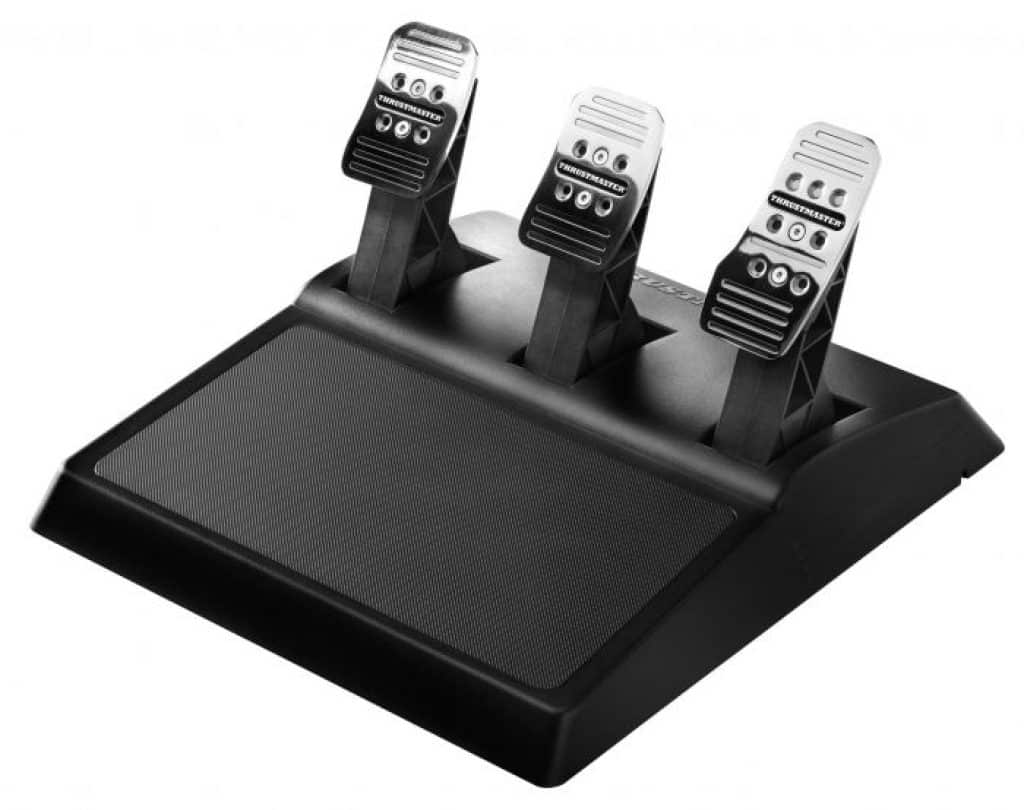
Thrustmaster T3PM
The latest mid-range Thrustmaster T3PM with T248 steering wheel.
- Number of pedals: 3
- Steering position: Formula
- Movement technology: Springs
- Pedal pressure: Accelerator 2.5Kg – Brake up to 200Kg – Clutch 5Kg
- Sensors: Magnetic (10-bit on console, 14-bit on PC)
- Adjustments: Pedal spacing and inclination, accelerator pedal height, 4 brake hardness modes
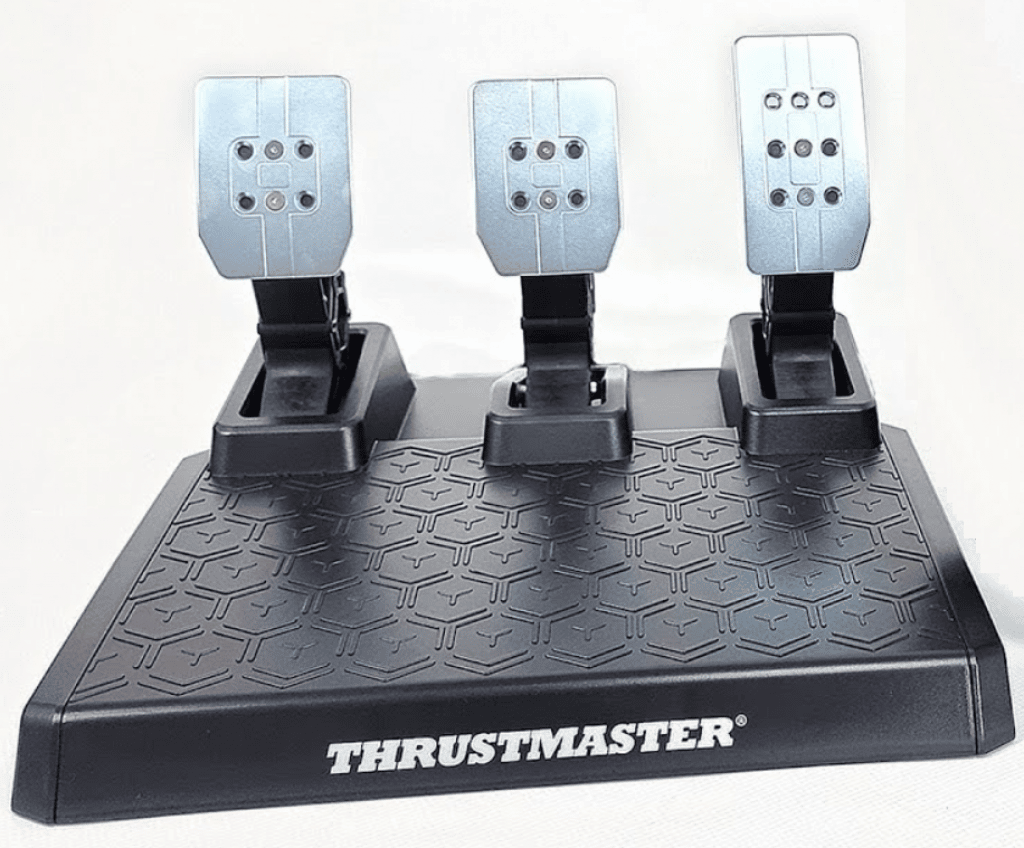
Thrustmaster TLCM
The new darling of drivers loyal to the Thrustmaster ecosystem! The T-LCM offers a host of interesting features. First, a Load Cell sensor that can be adjusted up to 100Kg of brake pressure. Next, a more refined design than the brand’s other cranksets, and finally 6 springs to create the ideal resistance for YOU.
- Number of pedals: 3
- Steering position: Formula
- Movement technology: Springs and high-density foam
- Pedal pressure: Accelerator 2.5Kg – Brake up to 100Kg – Clutch 5Kg
- Sensors: Magnetic (16-bit on PC, 14-bit on consoles) and Load Cell (100Kg capacity)
- Adjustments: Pedal spacing and inclination, accelerator pedal height, 6 springs for modulating brake hardness.
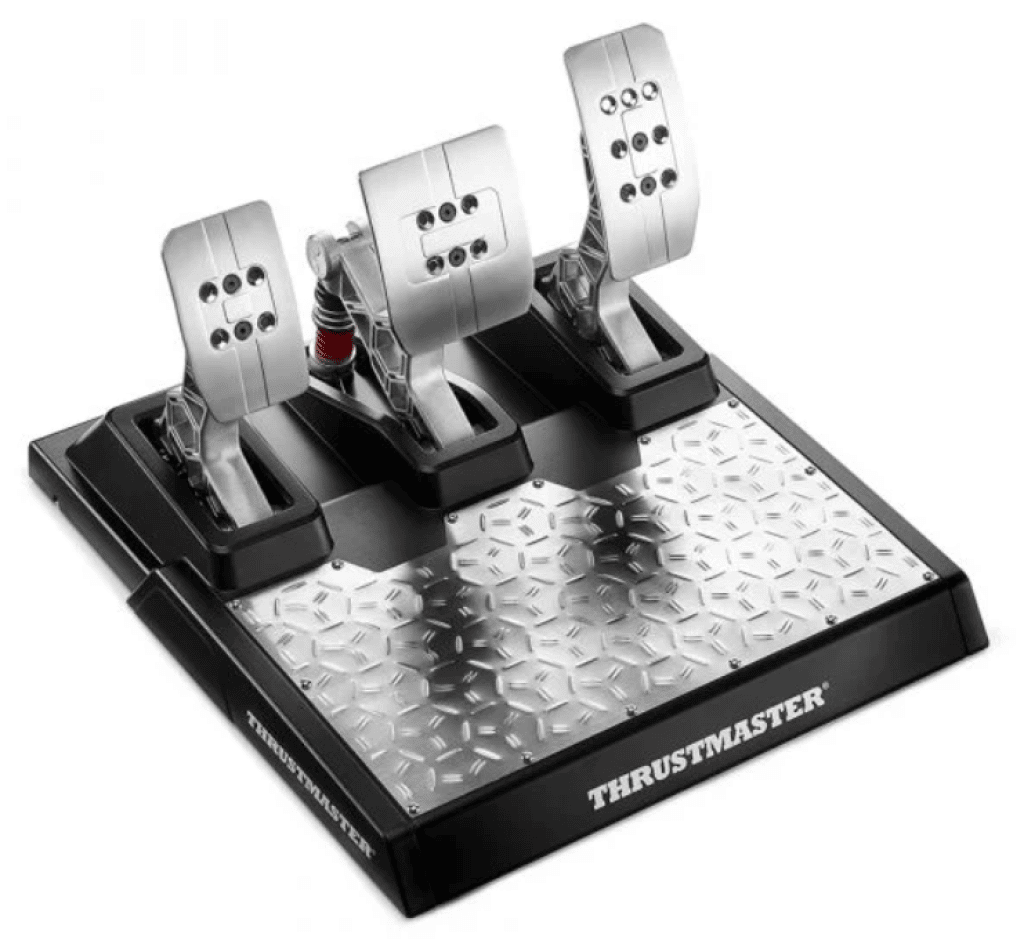
Fanatec pedals (PC and consoles)
Fanatec offers the richest ecosystem of any simracing brand. Their pedalsets are renowned for their quality, reliability and precision. The German brand is increasingly seeking to open up to the general public, offering top-quality models at prices that put the competition to shame. I’ll let you discover what they have in stock to create your dream cockpit!
Fanatec CSL Pedals
Riding position : Formula
Movement technology: Springs and high density foam
Sensors: Magnetic
Adjustments: Pedal spacing, possibility of adding a third pedal and/or a Load Cell kit
Less than €100 for a Fanatec pedalset? This new Fanatec pedalset arrived on the market at the same time as the Fanatec CSL DD wheelbase. It’s a full-metal pedalboard, solid, stable, well-designed and adjustable. It’s clearly an entry-level model from Fanatec, but it does the job very well! Add the Load Cell kit and you’ve got a great pedalboard at a great price.
Fanatec CSL Pedals LC
Riding position : Formula
Movement technology: Springs
Sensors: Magnetic and load cell
Adjustments: Pedal spacing
The CSL pedalset with Load Cell brake and clutch pedal. In my opinion, it’s the best value in its range. A Fanatec Load Cell for the price of an entry-level pedalboard is something to celebrate!
Fanatec Clubsport Pedals V3 and V3 Inverted
Here we come to the top range of Fanatec pedalsets. The V3 is a Best Seller model renowned for its excellent build quality, design, precision and adjustability. As a bonus, you’ll find vibration motors on the gas pedal and brake pedals.
The Clubsport V3 is the Formula version with the 3 pedals “on the ground”. Whereas the Clubsport V3 Inverted is the GT version with suspended pedals. Beware, however, of the price difference between the two models! Expect to pay €360 for the V3 and €600 for the V3 Inverted.
- Number of pedals: 3
- Riding position: Formula or GT (for V3 inverted)
- Movement technology: Springs
- Pedal pressure: Brake up to 90Kg
- Sensors: Magnetic and Load Cell
- Adjustments: Pedal spacing and inclination
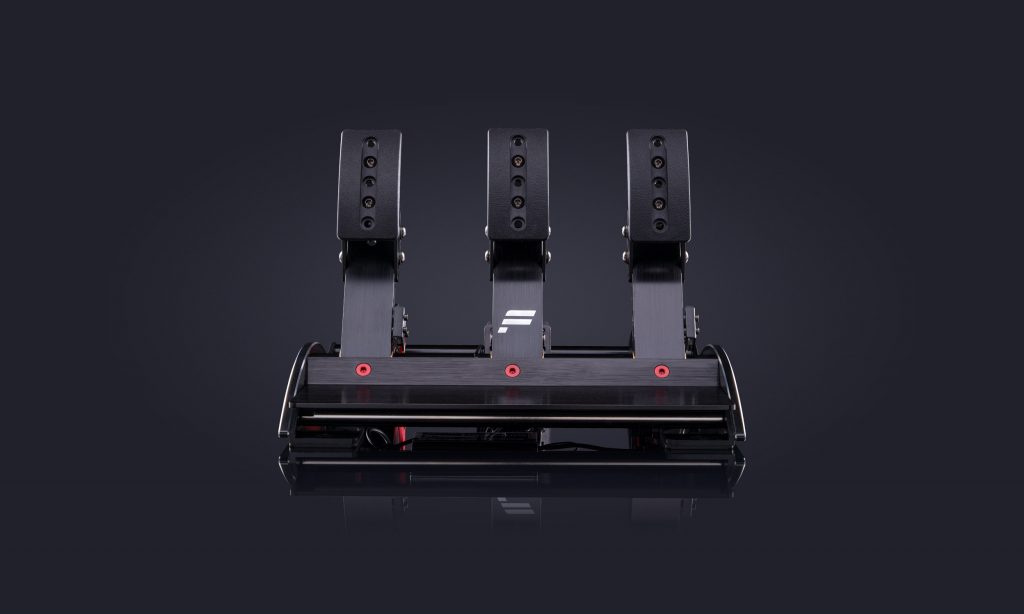
Perfect ! Go for the Fanatec Clubsport V3, this model is a success in every way. Quality of components, adjustments, pleasure of use, precision… It’s pure joy.
Asetek SimSports pedalset (PC)
Here’s a brand that’s finally refreshing the world of pedalboards. Asetek SimSport is a Danish firm that has been present in the simracing world since 2021. Its strengths? A real knowledge of real car racing. You could even say that car racing is a family passion at Asetek.
And it shows in their pedalboards! In fact, they’ve been the first for a long time to bring new technology to players’ feet. In what way? By significantly improving the feel of hydraulic pedalsets, bringing it even closer to that of a real racing car.
The result? Even Kevin Magnussen, no fan of simracing, decided to help Asetek further develop its technique to create the world’s most realistic simracing pedals.
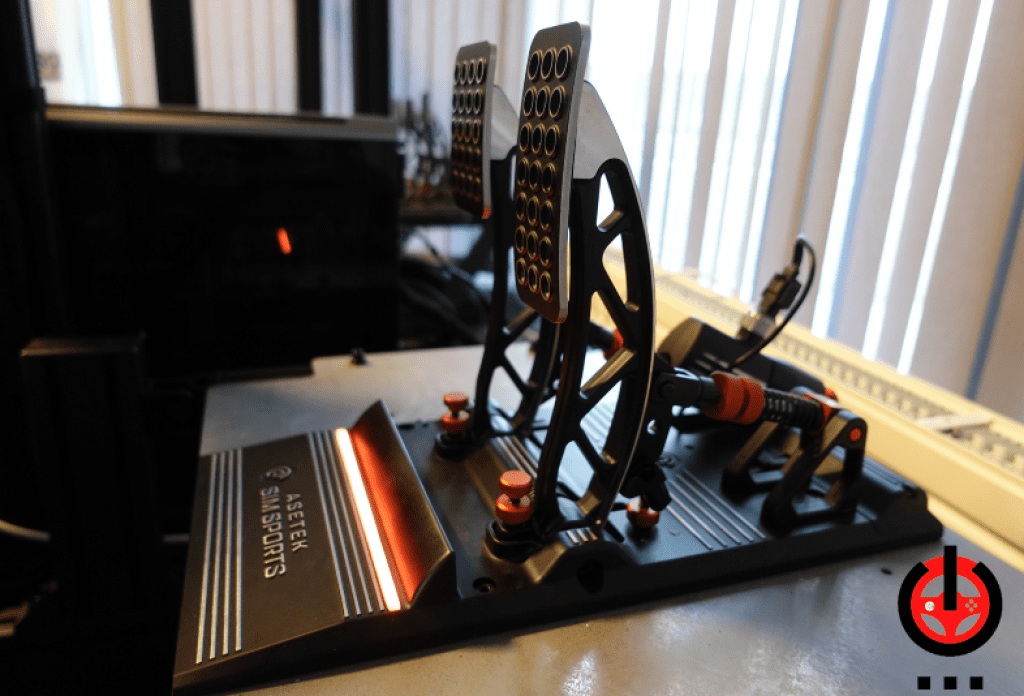

The Danes offer some truly superb products. We had the privilege of visiting their HQ and interviewing CEO André Eriksen! If you’d like to find out more about this promising new brand, click on the button below 😉
Probably the best pedalboard we’ve been lucky enough to have between the pedals to date.
And if you want to replace your Forte with an Invicta in the future, no need to sell everything! All you need to do is replace the brake cylinder with the Hydraulic module, this can be done literally in 3 minutes.
Heusinkveld pedalset (PC)
Heusinkveld has long been synonymous with quality and performance. Their pedalsets are part of the high-end simracing range. Even if the brand has chosen to relocate its production and change its materials for economic reasons, it’s still a fine piece of equipment. And let’s face it, very few brands can boast of being official suppliers of simracing pedalsets to the Mercedes-AMG Petronas Esport and Williams Esport Teams.
Venym pedalset (PC)
Looking for a top-of-the-range Made in France simracing pedalset? Take a look at the Venym website. Their team is made up entirely of racing enthusiasts, and their models draw some of their technology directly from Formule 4 and Formule 3 Regionale.
It’s beautiful, well-designed and the materials chosen (aluminum and carbon) are clearly top-notch. We had a chance to test them out at the ADAC Simracing Expo 2022. The feel of the pedalset is very similar to that of Heusinkveld. A testament to the quality of these pedalboards, which are also visually appealing!
Simtag pedalset (PC)
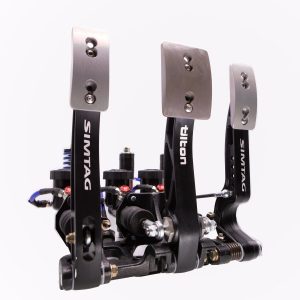
Simtag is a very, very fine piece of equipment. What stings is the price… Their pedalsets quickly cost the price of a small second-hand car… €1,600 to €3,200 for their hydraulic pedalsets. That’s why I haven’t yet taken the plunge and bought one to test. But I’ll let you discover a user’s very instructive test by following this link.
Build your own high-end simracing pedalset!
A few weeks ago, when I was looking for a pedalboard to replace my Fanatec Clubsport V3, I stumbled into a world that had never interested me more than that: Do It Yourself. I knew that with 3D printers, a soldering iron and a bit of time, feats could be achieved, but I didn’t expect to be slapped in the face like this.
I mean, really! Why pay between €1,000 and €3,000 or more for a top-of-the-range pedalset when you can get something even better for under €300 with just a little elbow grease? And when I say even better, I mean in almost every respect. Immersion, precision, performance and price!
Do you have a 3D printer and a DIY spirit? Then I strongly urge you to discover Lebois Racing!
The creator of Lebois Racing is a car simulation enthusiast who has created several models of pedals and even shifters that are far, far superior to anything on the market. I’ll let you discover his wonderful work by clicking right here! He gives away his manufacturing plans and all the documentation needed to do the job, free of charge. Yes, for free! All you have to do is buy the raw materials, spend 2 or 3 weekends on the project and you’ve got yourself a sick simracing pedalset.
As you can imagine, I’m already in the process of choosing a 3D printer to make one of these models. I’ll show you the manufacturing process and the final result in a future article 😉
So, which simracing pedalboard is right for you?
We’ve taken a very broad overview together. I hope you now have a much clearer picture of the world of simracing pedalsets! Whatever your budget and expectations, the brands have thought of everything to satisfy you. And it’s far from over! Every year we discover new, innovative brands created by real enthusiasts, and I’ll be sure to keep this guide up to date as time goes by 🙂
See you soon on the podium with your new setup!

